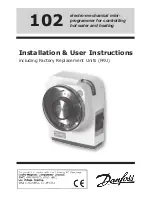
System Operation
Copyright © 2007-2018 Eaton Corporation. All Rights Reserved.
IPN 997-00012-03 B2 Issue B2 July 2018
59
Configuration
Set the following parameters.
Parameter
Description
Where to find:
System Overload
Type
The System Overload alarm can be based on
either
Total Capacity
or
Redundancy
.
If the system overload type is based on
Total
Capacity
then the alarm will trigger when the
load is above the
System Overload Threshold
for
the
System Overload Recognition Period
.
If the system overload type is
Redundancy N Plus
1,
then the alarm will trigger when the load is
above the total current capacity of the system
minus the current capacity of the largest rectifier,
for the
System Overload Recognition Period
.
If the system overload type is
Redundancy N Plus
2,
then the alarm will trigger when the load is
above the total current capacity of the system
minus the current capacity of the largest two
rectifiers, for the
System Overload Recognition
Period
.
An alarm will always activate if the system
overload type is set to Redundancy N Plus 1,
when there is only one rectifier installed, or
Redundancy N Plus 2, when there are only two
rectifiers installed.
DCTools/ Web: Alarms >
Alarm Configuration
System Overload
Type B
See System Overload Type above.
System Overload
Recognition Period
The System Overload alarm activates if the load
is above the threshold continuously for this time.
It is normally set to several hours so that the
alarm does not operate during a normal battery
recharge.
This setting is common to System Overload and
System Overload Type B.
System Overload
Threshold
The System Overload alarm activates if System
Overload Type is set to Total Capacity and the
load is above this threshold continuously for the
System Overload Recognition Period
. Measured as a
percentage of total rectifier capacity.
System Overload
Threshold B
See System Overload Threshold above.
















































